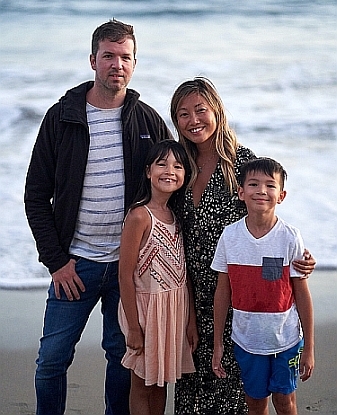FOCUS ON RETIREMENT
Barry & Denise (61/57)
Barry and Denise both had successful careers and made sensible financial decisions along the way. They suspected they were financially prepared for retirement but wanted to consult a professional financial planner to be sure and explore options.
Primary goals
- Establish a reliable stream of retirement income
- Optimize tax efficiency
- Minimize risk from market volatility

Background
Barry and Denise both led successful careers and regularly contributed to their respective retirement accounts (e.g., 401Ks and IRAs). Moreover, they invested additional savings in a sensible portfolio of low-cost exchange-traded funds (ETFs). Their history of disciplined savings and sensible investment decisions allowed them to accumulate a healthy nest egg.
Knowing how hard they had worked and how long it had taken to build their nest egg, they were conservative in nature and wanted to make the most out of every retirement dollar. So it was no surprise they made fees and taxes a focal point.
DIY
Based on their research and advice from friends, Barry and Denise felt confident their retirement was secure. So they decided to fund their retirement via a disciplined process of withdrawals from their investment portfolios. Their research indicated they could safely withdraw 3.5% of their initial nest egg in year one and increase that dollar amount by the rate of inflation each year going forward. When combined with Social Security income, they figured this would be adequate to cover their estimated spending budget.
As long as markets behaved as they did in the past, they should not run out of money and would likely be able to leave an inheritance for their children. Unfortunately, stock market volatility gave Barry and Denise a scare just six months into their retirement. They knew market volatility was inevitable and their calculations accounted for it, but their retirement did not feel the same even after an eventual market rebound.
Restoring peace of mind
Barry and Denise were concerned and wanted the opinion of a professional financial planner and reached out to me. After reviewing their situation, I first reassured them that their financial security was still intact. I then suggested two avenues for them to pursue. The first was to continue down their current path of chiseling from their portfolio, but with a few key changes. The second option was to mitigate the impact (both financial and mental) of market volatility by pre-chiseling much of the retirement income they would eventually need.
Adjustments to the current strategy
My advice first focused on improving their current withdrawal strategy. They were comfortable with this strategy before the recent market volatility. So it made sense to reiterate the reasons that was the case. However, there were also several adjustments I recommended to help them reduce fees and taxes:
- Asset allocation: Their overall allocations seemed sensible, but there were instances of what I call faux diversification within their portfolio. For example, they had accumulated a variety of funds over the years and some of them basically added up the whole market (e.g., small + medium + large-cap funds = the whole market). So it was more cost-efficient and simpler to replace many of these holdings with a single total market fund.
- Asset location: I spotted some tax-inefficient investments (e.g., bond funds where interest is taxed as ordinary income) in their taxable accounts. So I recommended moving (i.e., locating) them in retirement accounts to shield them from such taxes.
- Low-income period: Perhaps the most important suggestion I made was to delay their Social Security (SS) income. Not only would this likely increase the amount of SS income throughout their retirement, but it would also provide them with a higher baseline of inflation-adjusted income. However, the biggest benefit would likely come from converting IRAs to Roth IRAs during this period of lower-income and lower tax rates.
Big savings
I estimated the potential benefits from the above adjustments could save them at least six figures in taxes and fees throughout their retirement. This was welcome news as it increased their withdrawal rate by almost 15%. While this helped to install more confidence regarding their financial security, they still felt vulnerable to market volatility knowing they would be at the mercy of the market each time they withdrew from their portfolio.
Pre-chiseling
My second suggestion was to proactively structure much of your retirement income upfront - rather than wait to chisel away from the portfolio each year. This pre-chiseling approach involves two key adjustments at the outset.
The first adjustment is to the fixed income or low-risk side of the portfolio. Rather than maintaining a percentage allocation to portfolios of bonds or other low-risk assets, our goal would be to establish a baseline of guaranteed income throughout retirement. For example, we could first purchase bonds and CDs that mature over each of the next 15 years. Then we could purchase a deferred income annuity to extend this baseline of cash flows throughout their retirement.
Annuities?
Barry and Denise were surprised to hear a financial planner mention annuities. They had heard horror stories from others and assumed annuities were bad. So I took the time to explain. While stigmas exist around some annuity products (for good reason), our research and other academic studies show how income annuities can add significant value in the context of retirement income. In this case, the deferred income annuity would only be a fraction (<10%) of their overall portfolio. So our estimates indicated it would add just 0.035% in costs per year over a typical 30-year retirement.
Having explained how this first adjustment would establish a baseline of income that was guaranteed to last throughout their retirement, we moved on to the next adjustment. It was to the stock side of the portfolio. I proposed using stock portfolios comprised of only high-quality companies that had paid and raised dividends for at least 10 years. Historically, this approach has helped to reduce stock volatility. However, our primary goal here was to leverage the stream of dividends for income.
Dividend confusion
Many people conflate the notions of stocks prices and dividends. So I pulled out two charts to illustrate an important distinction. The first was a chart of market prices for a portfolio of dividend-paying stocks. The second chart showed the history of dividends paid by those companies. It was like night and day. The stock chart showed a wild squiggly line, but the dividend chart was smooth and increasing.
I proceeded to share some intuition regarding the dividends. In particular, they would just stack up on top of the baseline of fixed income. So this would target a natural and growing stream of income. Et voila! The portfolio did not need to be rebalanced. This would allow the stock portfolio (plus its dividends) to grow unconstrained. It also meant less (or no) rebalancing and fewer capital gains taxes.
Looking at the whole portfolio, I estimated this approach would reduce their investment-related taxes by approximately 30%. Moreover, it would keep the total costs of their retirement income right around 0.10% per year. They liked hearing this. They liked it more when I told them it included fees from the investment funds and income annuity.
Exciting simplicity
Barry and Denise were getting a little excited as I showed them variations of this building blocks approach to income. Never before had they seen such a simple, low-maintenance strategy with such benefits. In addition to the cost and tax benefits, they particularly appreciated how this relied on guaranteed income and dividends. That was a welcome break from chiseling away from the portfolio and being at the mercy of the market. Instead, we targeted a stable and increasing stream of income for them. This effectively transferred the market risk away from their retirement and to the eventual heirs of their portfolio.
If you are thinking about retirement, here are two links I think you will find helpful:
If you would like to discuss your investment or planning needs, book a free consultation with me using the button below:
WORKING & SAVING
Jeff & Sarah (44/43)
Jeff and Sarah are both working and saving. They are also busy chauffeuring their two kids around town to sporting events and other activities. They feel like they are moving in the right direction with their savings but experienced an unfortunate hiccup.
Primary goals
- Build and follow a financial plan
- Mitigate conflicts of interest
- Minimize taxes wherever possible

Background: Salesmen vs financial planners
Jeff and Sarah worked hard to get to where they are at. So they wanted to make every effort to secure and improve their family's financial situation. At one point, Sarah was promoted in her company and started earning significantly more money. So they decided to hire a professional to help them with their investments. They chose a financial advisor who worked for the bank where they already kept their checking accounts. This helped them keep their finances centralized in one place. Moreover, they were comforted knowing their bank was a well-known, national chain.
After sitting down with their new advisor, they proceeded to make several new purchases. This included multiple mutual funds, two 529 college savings plans, a variable annuity, and a whole life insurance policy. They also agreed to allocate the bulk of their monthly savings to the mutual funds going forward. Taking this first step toward their financial goals gave them comfort knowing someone was guiding them along the way.
Unpleasant discovery
Later that year, Sarah received a substantial bonus for meeting and exceeding several milestones in her new role. This provided an opportunity for them to revisit their finances and decide how to allocate this new money. This is when they discovered their new advisor's investments had significantly lagged behind the performance of both their 401K accounts.
Jeff and Sarah started doing some research on their investments. They quickly realized the products their new advisor sold them embedded steep fees that dragged down their performance. They also learned not all financial advisors were alike; some sold products for commissions and it created conflicts of interest. After a little more research, they decided they wanted to work with a bona fide fiduciary. In particular, they wanted to work with a financial planner that would focus on their long-term goals. That is when they reached out to me.
Establishing trust
As a part of our exploratory process, I audited their new investments and confirmed their suspicions. The products they had been sold had high fees and paid significant commissions to the advisor who sold them. These were telltale signs they were not working with a financial planner who has their best interests at heart.
I first started to analyze their portfolios and made two recommendations. The first was to liquidate the products from this advisor. The second was to allocate the proceeds to a balanced portfolio of low-cost index funds. This included rolling over their 529 accounts to another plan with lower fees and better funds to choose from.
Altogether, this move would lower their investment costs by approximately 1% per year. Moreover, it would save them on taxes over the long term. In the short term, it meant they would have to pay some surrender fees and taxes upfront. While tedious, I worked out the math for them. The fee savings alone would make up for this difference in just a couple of years.
I then reviewed their employers' benefits packages. I was pleased to find Jeff and Sarah both already had life insurance policies in place through their employers. Moreover, this provided them access to more coverage that was significantly cheaper than what they had been sold.
Thinking ahead: Retirement
Jeff and Sarah were both curious about retirement. What would it look like if they continued along their current trajectory of saving and investing? So I showed them my financial planning models. They liked my income-based approach. It gave them a stronger intuition for how their investments would eventually translate into retirement income down the road. They also liked this approach because it was more tax-efficient. It did not require portfolio rebalancing like traditional approaches. So this helped avoid capital gains taxes.
Jeff and Sarah believed it was important their advisor understood and would help them achieve their long-term financial goals. Moreover, they wanted to focus on their work and family. So they were eager to start working with a real financial planner who would function as their family CFO.
If you would like to discuss your investment or planning needs, book a free consultation with me using the button below:
BUSINESS OWNERS
Tom & Joanne (59/52)
Tom and Joanne were planning to sell a business they had built over the last twenty years. Having established an estate plan with their attorney, they surveyed the usual bank suspects to help them manage their investments. However, they decided they wanted a more creative financial planner. Specifically, they wanted help optimizing tax efficiency while they invested and passed money on to heirs and charitable causes.
Primary goals
- Business sale
- Tax-efficient plan for investing and philanthropy
- Innovative strategy

Background
Over the last few decades, Tom and Joanne focused almost all their energy on two things; They raised their children and grew their business. Their attention was now changing as they planned to sell the business within the next few years. Having neglected it for some time, they recently started implementing an estate plan with their attorney. They utilized their estate tax exemptions to set up trusts for their children. So this left them with approximately $25 million in savings including several million dollars in traditional and Roth IRAs.
Tom and Joanne both wanted to find a financial planner to help them maximize tax efficiency without compromising investment performance. They interviewed several big-bank wealth management firms. However, they felt their focus was on investment management rather than financial planning. That is when one of their friends referred them to me.
A creative financial planner
The sale of their business was a pressing matter and tax efficiency was a priority. So we briefly discussed some alternative strategies they could consider. Another advisor suggested a 1042 employee stock ownership plan (ESOP) transaction. So they were momentarily interested in the idea of selling the company to their employees. This could defer taxes on the proceeds if they invested them in qualified replacement property (QRP). The acronyms alone were a bit scary and they were already comfortable with the idea of a cut-and-dried sale. They reasoned this was sensible with long-term capital gains tax rates at historic lows.
Adding value
Our discussion moved on to how they could manage their investments and maximize tax efficiency. This was an important concern as they moved into the next phase of their life after the business sale. They knew they would have more wealth than they needed and wanted to give back to causes they supported. So I highlighted some key strategies to integrate into their financial plan:
- Leverage tax-free municipal bonds for their taxable bond allocation(s).
- Build the equity portfolio with individual stocks (rather than funds) that did not pay dividends (e.g., Warren Buffett's Berkshire Hathaway). This would naturally avoid taxes on dividends. However, it would also allow them to harvest losses and use highly appreciated winners for charitable donations.
- Set up a donor-advised fund (DAF). This was effectively gifting money that was irrevocably earmarked for charities. They could fund this with investments that had already appreciated. So this would avoid the capital gains and grow the portfolio tax-free going forward.
- Donate minimum required distributions (RMDs) to charities to avoid creating taxable income.
- Designate beneficiaries of their IRAs so that after-tax Roth funds went to their highest-earning beneficiaries. This would help minimize the income tax eventually paid on the traditional IRAs.
They were already aware of some of the above strategies. However, they really liked the idea of a financial planner could be so creative. For example, this was the first time they heard of the idea for the individual stock portfolio. They also had not thought of the tax-aware beneficiary designations on their traditional and Roth IRAs. These strategies could help them minimize both income and investment-related taxes while benefiting causes they wanted to support.
If you would like to discuss your investment or planning needs, please book a free consultation with me using the button below:
ENGINEERS
Mark & Evelyn (62/57)
Mark was an engineer and always worked for himself consulting on matters related to turbine engines for fighter jets. Evelyn was also an engineer, but she had mostly worked for large companies. She only recently joined Mark in his practice. They always found markets, economics, and investing fascinating. With retirement on the horizon, they decided it was time to seek out a professional financial planner.
Primary goals
- Build and follow a financial plan
- Maximize tax-efficiency
- Concrete financial model

Background
Mark and Evelyn had committed to paying for their kids' college educations. So their finances improved significantly after both children graduated several years before we met. They had already saved what they believed they would need for retirement. So Evelyn decided to leave her corporate job and join Mark in his practice. They viewed this as a step in the direction of their eventual retirement in a handful of years.
On one hand, they knew they had saved well and had accumulated a nice nest egg. On the other hand, they wanted to understand how their assets would replace their working income once they retired.
They interviewed financial planners through the years, but never found a good fit. Both Mark and Evelyn relished analytical conversations and constantly kicked tires by asking probing questions. They simply could not find a financial planner who could establish a concrete link between their assets and future income. However, they felt the responses they received made a tenuous connection at best between these two variables.
Meeting a competent financial planner
After meeting Mark at a local charitable event, he warned me he had "done the dance" with other advisors. So the bar was high. Undeterred, I brought up a couple of topics that I thought an analytical mind would appreciate.
It was clear we both liked index funds due to their low costs and tax efficiency. However, I then pointed out several little-known details regarding the mechanics of index funds and offered to share two of my research articles on the topic.
We then started to discuss his traditional and Roth IRAs. Mark understood the primary difference between traditional and Roth IRAs to be what income tax rate would likely be applied. I pointed out another angle most people missed. By doing away with RMDs, Roth IRAs were able to extend tax benefits longer than with traditional IRAs. While he was skeptical at first, my research on the topic convinced him.
The last topic we discussed involved Evelyn's retirement assets from her previous employer. She had built up a seven-figure 401K, but also owned a significant amount of company stock. They both knew about the traditional options to rollover the 401K into an IRA. However, they had not heard of the IRS rules for net unrealized appreciation (NUA). This special provision allowed her to tax-efficiently extract much of her company stock. This significantly reduced the taxes they would ultimately pay by converting many taxes from ordinary income to capital gains.
Fast-forwarding a few years
Evelyn is now fully retired and Mark is about one year out. They have already planted the seeds for a portfolio that will naturally generate income for their retirement. However, they also implemented several smart moves to reduce their taxes along the way:
- Maximizing retirement account contributions via a SEP IRA and personal defined benefit. Now that Mark and Evelyn were self-employed, they could both use these types of retirement plans. That allowed them to supercharge their retirement with six-figure worth of tax-deductible contributions per year.
- Disciplined process of Roth conversions. This process will start as soon as Mark retires and they are in a significantly lower tax bracket.
- Leveraging IRS NUA tax treatment: Evelyn had company stock in her retirement plan and saved approximately 50% off her tax bill by extracting half of her company stock via a net unrealized appreciation (NUA) transaction while rolling the rest of it along with her 401K into an IRA.
While Mark and Evelyn both found markets fascinating, it was not where they wanted to channel their energies. They were naturally happy when they found a financial planner they could trust. However, they got the most satisfaction knowing I understood their situation and came up with value-added solutions.
If you would like to discuss your investment or planning needs, please book a free consultation with me using the button below:


